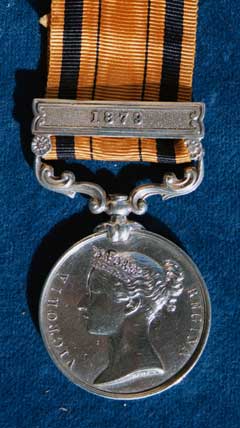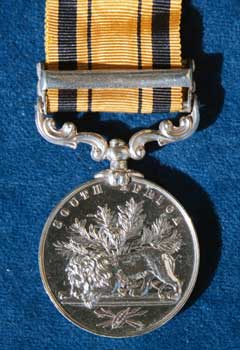 |
King's Own Royal Regiment Museum Lancaster |
|
|
HOME Museum & Collections Sales Donations Events Contact Us REGIMENTAL HISTORY 17th Century 18th Century 19th Century 20th Century First World War Second World War Actions & Movements Battle Honours FAMILY HISTORY Resources Further Reading PHOTO GALLERY ENQUIRIES FURTHER READING LINKS |
MEDAL INFORMATION South Africa Medal (25 Sept 1877 to 2 Dec 1879)
Face
Rear
Size
Ribbon
Suspension
Naming
Bars
Awarded 1. The Galekas and Gaikas from 26 September 1877 to 28 June 1878 2. Chief Pokwane from 21 to 28 January 1878 3. The Griquas from 24 April to 13 November 1878 4. The Zulu’s under Cetewayo and his lieutenants from 11 Jan to 1 Sept 1879. 5. Chief Sekukuni from 11 November to 2 December 1879. 6. Chief Moirosi in the Drakensberg from 25 March to 20 November 1879. Most of these wars were small affairs fought mainly by the many Colonial units raised for specific purposes, such as that of capturing the Basuto Chief. Chief Moirosi refused to pay taxes and occupied a strongly defended position in the Drakensberg mountains where he was ultimately killed. This medal is best known, as the “Zulu War Medal”, with the clasps bearing the year 1879, awarded to those in the campaign against Cetewayo, who had been crowned King of the Zulu nation in 1873. Troubles developed in South Africa during the 19th Century as the expansionist policies of the Boers and the British, deprived the native tribes of their most fertile lands. Some, including Sir Bartle Frere, High Commissioner for Native Affairs in South Africa, saw the Zulus with their powerful army, as a threat to be dealt with, despite Cetewayo having kept his people quiet during the Ninth Kaffir War of 1878. Eventually, following some minor troubles, Frere presented Cetewayo with an unacceptable ultimatum. This threatened the Zulus' independence and was rejected. As a result a British military force of five columns under Lord Chelmsford entered Zululand on 11 January 1879. On the 22nd January a mixed force of about 1700 men in an ill-prepared camp near Isandhlwana Hill, was surprised by a Zulu army of perhaps 20,000 men and was almost wiped out in about 2 hours. Later the same day the small garrison of 139 men at Rorke’s Drift was attacked by about 3000 Zulus and held out for about ten hours before being relieved the following morning. Three Victoria Crosses were awarded for the former action and eleven for the latter. Eventually the war took a more favourable turn for the British and Cetewayo was defeated on 4 July at the battle of Ulundi. The war finally ending in September.
The King’s Own South Africa Medals in the museum's collection
The South Africa 1879 Medal 'Zulu War' |


